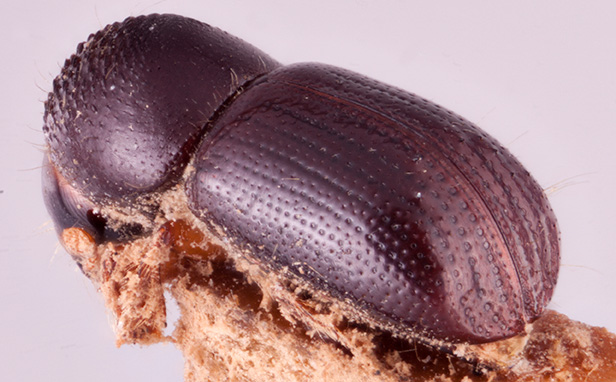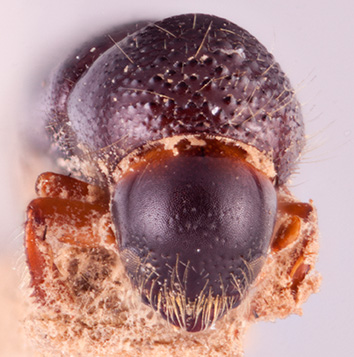Anisandrus improbus
|
Anisandrus improbus holotype lateral; R.K. Osborn |
|
Anisandrus improbus holotype dorsal; R.K. Osborn |
|
Anisandrus improbus holotype declivity; R.K. Osborn |
|
Anisandrus improbus holotype frontal; R.K. Osborn |
Taxonomic history
Xyleborus improbus Sampson, 1913: 444.
Anisandrus improbus (Sampson): Hulcr et al., 2007: 578.
Diagnosis
3.3−3.4 mm long (mean = 3.4 mm; n = 2); 2.43−2.54 times as long as wide. This species can be distinguished by the mesonotal mycangial tuftmycangial tuft:
tuft of setae that denotes the mycangia exterior opening
 the length of the scutellumscutellum:
the length of the scutellumscutellum:
a shield-like sclerotized plate located at the midpoint of the elytral base
; elytralelytral:
pertaining to the elytra
discdisc:
the flat central upper surface of any body part (e.g. pronotum and elytra) convexconvex:
convexconvex:
appearing rounded ; declivitydeclivity:
; declivitydeclivity:
downward slope of either the pronotum or elytra
 appearing flat when viewed laterally; declivitaldeclivital:
appearing flat when viewed laterally; declivitaldeclivital:
pertaining to the elytral declivity
striae clearly impressedimpressed:
a depression in a surface
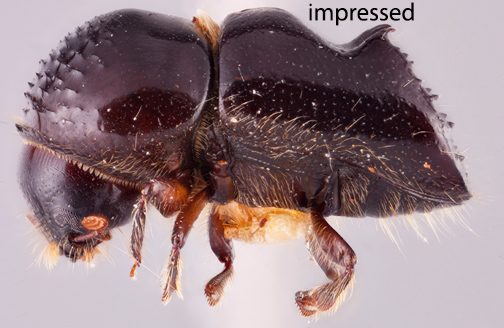 ; declivitaldeclivital:
; declivitaldeclivital:
pertaining to the elytral declivity
summit armed by a minute denticledenticle:
a small tooth, the sides of which are equal and the tip is above the middle of the base on interstriaeinterstria:
on interstriaeinterstria:
longitudinal spaces along the elytra between the striae, which is not as<br />
impressed and bear smaller punctures.
 2−3; granulesgranule:
2−3; granulesgranule:
a small rounded protuberance, like grains of sand
 present on basalbase:
present on basalbase:
point or edge closest to the body; opposite of apex half of interstriaeinterstria:
half of interstriaeinterstria:
longitudinal spaces along the elytra between the striae, which is not as<br />
impressed and bear smaller punctures.
 2−4; posterolateralposterolateral:
2−4; posterolateralposterolateral:
relating to end of the side part/portion
 margin costate to interstriaeinterstria:
margin costate to interstriaeinterstria:
longitudinal spaces along the elytra between the striae, which is not as<br />
impressed and bear smaller punctures.
 7; declivitaldeclivital:
7; declivitaldeclivital:
pertaining to the elytral declivity
face strongly shiningshining:
appearing glossy or bright in luster; referring to a surface that is polished and reflects light well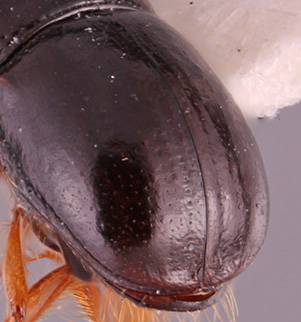 ; and declivitaldeclivital:
; and declivitaldeclivital:
pertaining to the elytral declivity
interstriae clearly punctatepunctate:
set with fine impressed points, appearing as pin pricks
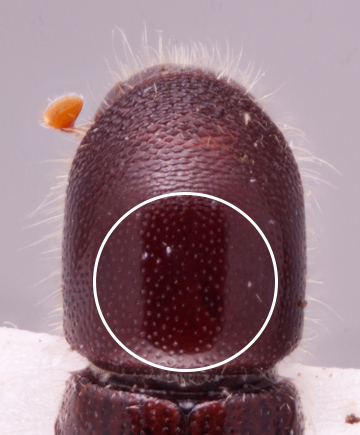 .
.
May be confused with
Anisandrus eggersi, A. feronia, and A. mussooriensis
Distribution
China (Xizang), India (Assam, West Bengal)
Host plants
recorded from Quercus (Fagaceae), Machilus (Lauraceae) and Eucalyptus (Myrtaceae) (Maiti and Saha 2004Maiti and Saha 2004:
Maiti PK, Saha N. 2004. Fauna of India and the adjacent countries. Scolytidae: Coleoptera (bark and ambrosia beetles). Vol. 1. Part 1. Zoological Survey of India, Kolkata, 268 pp.)
DNA data
specimens not available for sequencing



